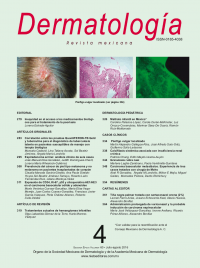Resumen
ANTECEDENTES: la terapia biológica se asocia con aumento del riesgo de reactivación de la tuberculosis latente, lo que requiere evaluación previa al inicio del tratamiento, ya sea con prueba cutánea de tuberculina, QuantiFERON o ambas.
OBJETIVOS: comparar el resultado de QuantiFERON-TB Gold® y la prueba de tuberculina en pacientes susceptibles de recibir terapia biológica. Establecer si existe correlación entre los resultados de ambas pruebas.
MATERIAL Y MÉTODO: estudio descriptivo, prospectivo, de corte transversal, comparativo de dos pruebas diagnósticas; se aplicó QuantiFERON-TB Gold® y prueba de tuberculina en 105 pacientes susceptibles de recibir terapia biológica. Se determinó sensibilidad, especificidad, valores predictivos positivos y negativos de cada una de las pruebas y la correlación entre ambas.
RESULTADOS: se incluyeron 105 pacientes con edad promedio de 50.7±13.5 años. La prueba de tuberculina mostró sensibilidad de 69%, especificidad de 49%, valor predictivo positivo de 42% y valor predictivo negativo de 75.5%. Mientras que con el QuantiFERON la sensibilidad fue de 42%, la especificidad de 76%, el valor predictivo positivo de 69% y el valor predictivo negativo de 49%. La correlación (análisis kappa de Cohen) entre ambas pruebas fue de 0.18.
CONCLUSIONES: la tuberculina mostró mayor sensibilidad, pero baja especificidad, ratificando la necesidad de una prueba confirmatoria. El QuantiFERON-TB Gold In Tube demostró mayor especificidad con valores predictivos positivos altos, lo que valida su uso en la confirmación de las pruebas de tuberculina positivas. La implementación de esta prueba podría disminuir las tasas de resistencia a los medicamentos antituberculosos y toxicidad farmacológica por administración innecesaria de profilaxis.
Palabras clave: psoriasis, tuberculosis latente, tuberculina, TST, interferon-gamma release assay, IGRA, QuantiFERON-TB Gold.
Abstract
BACKGROUND: Biological therapy is associated with increased risk of reactivation of latent tuberculosis, which requires assessment prior to initiation of therapy, either tuberculin skin test, QuantiFERON or both.
OBJECTIVES: To compare the result of QuantiFERON-TB Gold® and tuberculin test in patients for initiation of biological therapy. To establish whether there is a correlation between the results of both tests.
MATERIAL AND METHOD: A descriptive, prospective, cross-sectional, comparative study of two diagnostic tests: QuantiFERON-TB Gold® and tuberculin test. Both tests were performed in 105 patients. Sensitivity, specificity, positive and negative predictive values for each test and correlation between them were determined.
RESULTS: We included 105 patients with an average age of 50.7±13.5 years. The tuberculin test showed sensitivity of 69%, specificity of 49%, positive predictive value of 42% and negative predictive value of 75.5%. While the QuantiFERON sensitivity was 42%, specificity 75.6%, positive predictive value was 69% and the negative predictive value of 49%. The correlation (Cohen kappa analysis) between the two tests was 0.18.
CONCLUSIONS: Tuberculin showed to have greater sensitivity, but low specificity, confirming the need for a confirmatory test. The QuantiFERON-TB Gold In Tube showed greater specificity with high positive predictive values, validating its use in confirming positive tuberculin tests. The implementation of this test could lead to a decrease in rates of tuberculosis drug resistance and unnecessary drug toxicity by use of prophylaxis.
Keywords: psoriasis; latent tuberculosis; tuberculin; TST; interferon gamma release assay; IGRA; QuantiFERON-TB Gold

